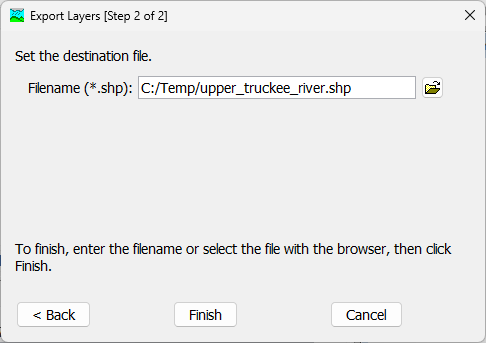Download PDF
Download page Task 1: Importing Gridded Data.
Task 1: Importing Gridded Data
Return to Introduction to Downloading, Importing, and Processing Gridded Data
Last Modified: 2025-01-28 14:08:22.977
This task can be completed as part of the Downloading, Importing, and Processing Gridded Data tutorial or as a stand-alone activity.
HEC-HMS version 4.13-beta.4 was used to create this example. You can open the example project with HEC-HMS v4.13-beta.4 or a newer version.
Introduction
In this workshop, you will use HEC-HMS Gridded Data Import Wizard to import gridded precipitation data.
Run the MRMS simulation
Open the Upper_Truckee_River project in HEC-HMS.
Run the WY2017_MRMS simulation run.
View the Snowmelt Graph for the WY2017_MRMS simulation run at the UpTruckeeRv_S10 element.

Notice the discrepancy in computed Snow Water Equivalent (SWE):

The discrepancy in SWE could be attributed to a number of things, including the snowmelt calibration. In this study a closer examination of the precipitation data revealed a systematic bias in the precipitation data in comparison to other precipitation datasets. This tutorial will demonstrate how to apply a volume adjustment to the precipitation data to achieve better agreement between computed and observed SWE.
Export a clipping shapefile
Gridded earth science data is often distributed at global and continental scales. Clipping the data on import reduces the size of the data on disk and increases the performance of the simulation. In order to clip the data a clipping domain must be provided in the form of a shapefile.
In the Watershed Explorer, select the WY2017_TI Basin Model node.
From GIS | Export Layers, launch the Export Layers dialog.
Select layer type Subbasins.
Select a location on your computer to export the shapefile.
Reminder
Remember the location of this shapefile. You will use it in Tasks 1-4.
Download PRISM precipitation data
PRISM stands for Parameter-elevation Regressions on Independent Slopes Model. As the name indicates, the PRISM dataset emphases accuracy for highly orthographic regions like the western United States. The PRISM climate group gathers climate observations from a wide range of monitoring networks and applies sophisticated quality control measures to develop gridded climate datasets. PRISM data is collected using a horizontal resolution of 800 meters and is provided to users at a resolution of 4 kilometers. Datasets are available in ASCII (“*.asc”) or BIL (“*.bil”) format. Data is available from 1981 to present for most PRISM products including 30-year normals, daily, and monthly records.
The WY2017_TI simulation run simulates water year (WY) 2017. PRISM data can be downloaded for entire calendar years. To cover WY 2017, download PRISM daily precipitation data for calendar year 2016 and 2017 in BIL format as demonstrated in the below figure.

Import PRISM precipitation data
Convert the data in BIL format to HEC-DSS using the Gridded Data Import Wizard.
First, unzip the PRISM *bil.zip files that were downloaded.
In HEC-HMS, navigate to File | Import | Gridded Data | Importer to launch the Gridded Data Import Wizard.
On the first step of wizard select BIL files for the period 1-Oct-2016 to 30-Sep-2017.
Reminder
The individual *.bil files for WY 2017 will come from two different file downloads. Be sure you have selected files for 1-Oct-2016 to 30-Sep-2017 before proceeding.
On the second step of the wizard select the "ppt" variable for import.
On the third step of the wizard specify resampling parameters:
- The Clipping datasource specifies the spatial extent the data will be clipped to. Use the shapefile that was exported in Exporting a clipping shapefile.
- The Target WKT is the projection, in Well Known Text format, that the data will be projected to. Use the globe on the right to select the SHG projection.
- The Target cell size is the grid cell size that the data will be resampled to. Use the grid button on the right to select 2000 meters.
- The Resampling method is the method used to resample the data. Select the Bilinear resampling method.

On the fourth step of the wizard save the data to a file named PRISM.dss in the <path to>/Upper_Truckee_River/data directory.
Click Next to import that data. The PRISM.dss file should only be about 1MB, much smaller than the original, unclipped PRISM data.
View Data in HEC-DSSVue
Open the PRISM.dss file in HEC-DSSVue.
Select one to many of the DSS records, then click the plot button to view the gridded data.


Summary
In this tutorial:
- A clipping shapefile was exported from HEC-HMS,
- PRISM data was downloaded,
- PRISM data was imported to HEC-DSS using the Gridded Data Import Wizard,
- and, imported data was viewed in HEC-DSSVue.
The task is part of the Downloading, Importing, and Processing Gridded Data tutorial. You can continue to Task 2: Extracting time-series data from grids with existing project files. You can download the final project files for this task here:
Continue to Task 2: Extracting time-series data from grids
